
Traditional dress of Poland, or’stroje’, is a lively representation of the country’s rich cultural past. Each item, covered with delicate needlework and colourful designs, offers a tale about historical epochs, representing Poland’s artistic brilliance as well as rich history.
These costumes, having transcended their status as museum displays, continue to inspire modern fashion trends. The growth of the traditional dress of Poland throughout the ages reflects the country’s distinct regional cultures, as witnessed in numerous Polish towns.
Ornate headdresses in Pomerania represent cultural wealth, while coastal-inspired outfits highlight the region’s marine past. Each Polish area has its particular style that reflects its cultural uniqueness.
Lesser-known locations like Lubusz and Kuyavia also add to the complex tapestry of traditional dress of Poland, which has been influenced by historical characters such as Casimir the Great as well as Queen Jadwiga.
Their heritage is intimately intertwined with the materials that make this traditional dress of Poland.
These areas’ costumes have been formed by influences from colonisation, and assimilation, as well as historical characters, much like Poland’s diverse religious landscape, resulting in compelling stories weaved into the fabric.
The traditional dress of Poland is more than simply apparel; it represents the tradition and personality of each Polish area. This article digs into the traditional dress of Poland, highlighting the complex detailing as well as brilliant colours that distinguish its distinct style.
We look at the beauty as well as the diversity of conventional Polish dress, from the vibrant patterns to the cultural meaning of each piece.
Let’s go through the 100-year-old closet and reveal Poland’s most stunning traditional dress!
1. Amaranth coats & black embroidery
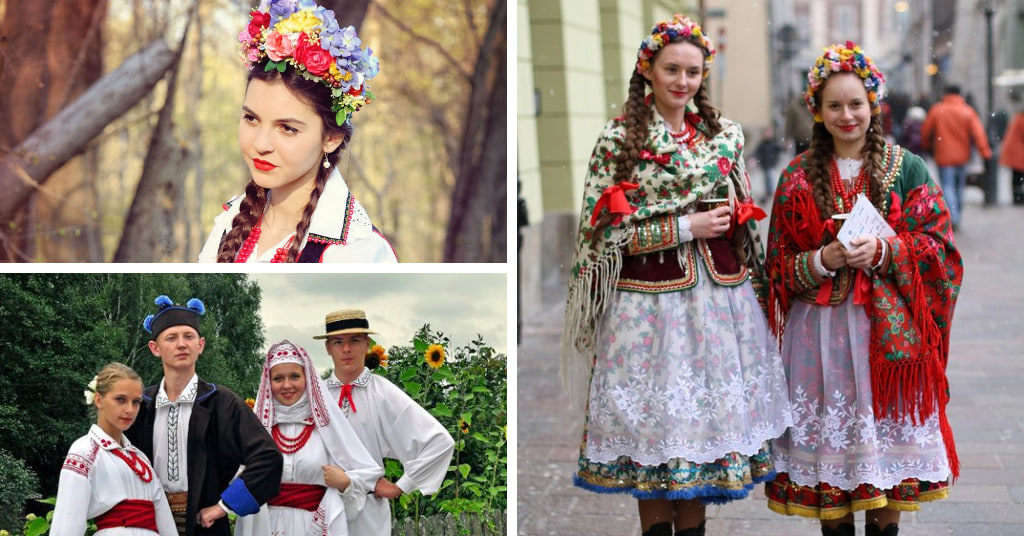
Legend tells that the original Wilanów costume was inspired by the decorative gate of Jan III Sobieski’s Palace in Warsaw’s Wilanów area.
The outfit is a characteristic style dress for this portion of the Masovia area, with stunning black embroidery decorating the upper part of the white sleeve of women’s shirts – an arrangement adopted by contemporary ethno-designers.
Ankle-length skirts were covered by somewhat shorter aprons in white, blue, green, or various colours of yellow. Pastel-coloured silk ribbons are braided around the hair, along with beaded necklaces.
Maidens wore their braided ponytails topped with a crown, while wedded ladies wore a white, stitched linen coif head scarf. Men finished off their outfits with towering top hats as well as felt hats.
Last but certainly not least, peasants’ traditional coats, known as sukmanas, were often navy blue along with dark green. Oskar Kolberg, polish ethnographer, folklorist, as well as composer who produced dense collections of Polish folk songs organised by area, wrote: “During holidays, the poor people of Masovia donned blue sukmana, that were knee length, alongside amaranth coloured front as well as strings.”
Until the nineteenth century, persons dressed in this way could be seen along the Vistula River’s left bank, from Wilanow through Powsin, Nadarzyn, Raszyn, as well as Piaseczno.
2.Peacock feathers & Tadeusz Kościuszko
Tadeusz Kościuszko, the commas well as er of the 1794 Uprising, disguised from Russian spies by wearing ‘like a peasant’ in the Kraków costume, earning the outfit national glory and importance.
Kościuszko made an oath of fidelity to the country in the Krakow market square, clad in a white sukmana, to highlight the importance of the infantry in command of peasant individuals (known as kosynierzy or scythemen) in achieving victory at Racławice.
Kościuszko’s fame led to the spread of the Kraków costume across Polas well as. Jadwiga Koszutska, a national dress specialist, outlines how some components, particularly the sukmana and the distinctive peaked caps known as rogatywka, were incorporated into the uniforms of 19th-century national revolutionaries.
The Kraków women’s attire gained popularity among the Młoda Polska or Young Polas as well as groups. Peacock feathers attached to hats, white aprons, intricately embroidered silk corsets, as well as red beaded necklaces were popular.
3.Vermilion, white & violet: the Łowickie strips
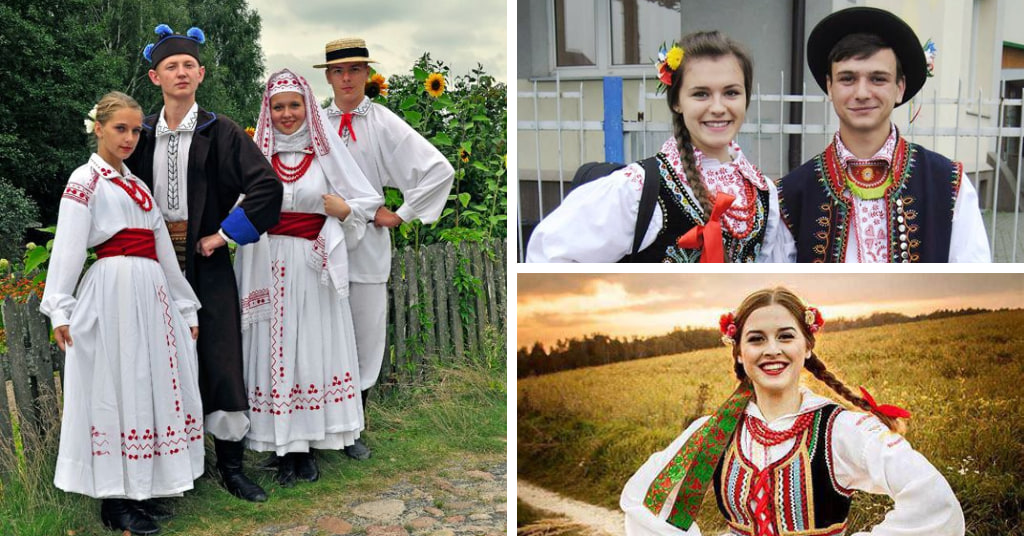
The attire of the Łowicz central regions, known as one of Polas as well as ‘s richest, most beautiful, most glamorous traditional costumes, is still worn during celebrations and national holidays.
It has altered on several occasions over time. Stripes of various colours, forms, as well as sizes can be found on women’s skirts, dresses, thick woollen clothes, aprons, corsets, as well as caftans, as well as men’s pants. In the second part of the nineteenth century, red materials were predominant in tiny individual strips or beams.
The Łowicz costume underwent a metamorphosis around the beginning of the twentieth century & history of poland.
Read this also:- Best 5 summer outfits trends that you need in invest in 2024
The strips were laid on an orange backdrop, as well as the green strips were varied as well as enhanced by the addition of vermilion, white, and violet.
The most significant modifications, particularly in women’s costumes, occurred during the Interwar era. Colder tones, such as greens, violets, as well as emeralds created with aniline dyes, dominated the striped fabric colour pallet.
The unique materials, hues, and beauty of the Łowicz dress inspired replication in other locations.
4. Kujawiak ‘enriched, amply covered & pleated’
Not all of the original parts of the Kujawy region’s costume have survived, but we are grateful that many artists have depicted it in their works. Wojciech Gerson’s paintings from the mid-nineteenth century provide the most complete portrayals.
Oskar Kolberg utilised the las well as scape painter’s painting for illustrations in the volume Kujawy, which was published in 1867. Zofia Stryjeńska, a well-known Interwar painter as well as fabric designer, influenced the Kujawy outfit via her art.
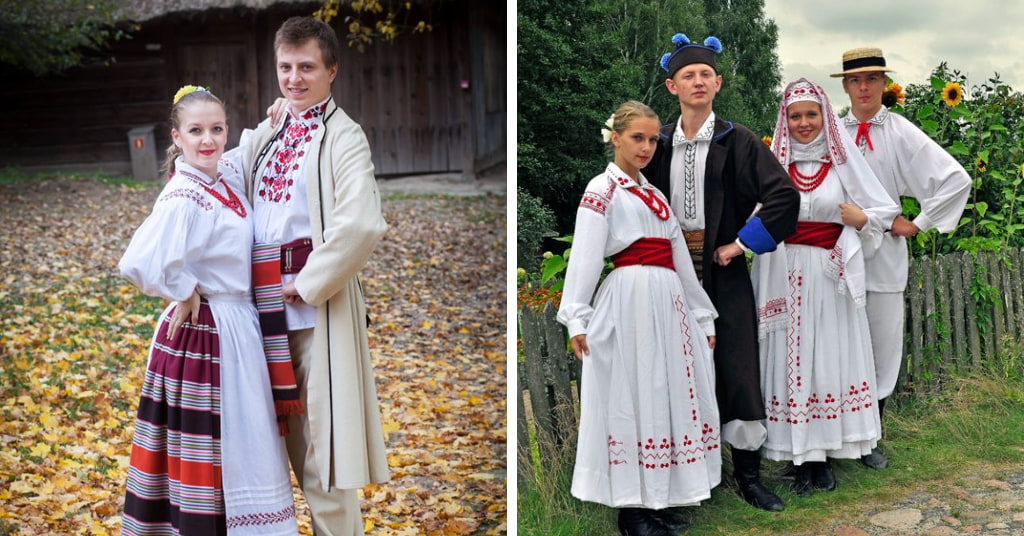
The Kujawy costume is easily identified by its original headpieces, which included a fur hat knotted at the side, shepherd hats with wide brims, peaked caps, and caps with a characteristic visor worn cheekily sideways.
For the males, add a linen shirt as well as a silk scarf knotted over their necks. Scarves were worn by maidens on Sundays, whilst married women wore scarve-adorned headpieces known as kopki.
Women finished off their ensembles with a corset, a sukmana, a skirt, an apron, and the requisite jewels.
5. Clogs & amber pipes
The Kurpie area of green and white primaeval woodlands was known for its modest and devoid of embellishments masculine clothing. Starting with the head, the rogatywka, a peaked cap made of braided pine roots and featuring a patented visor, was the height of vogue.
During summer, Józef Piłsudski wore a broadcloth hat known as a maciejówka. Clogs would be worn on wrapped-up feet, or boots with boot tops (a status signal). In the winter, the most costly piece of men’s clothing is a brown sukmana as well as a sheepskin coat featuring a black sheep-fleece collar.
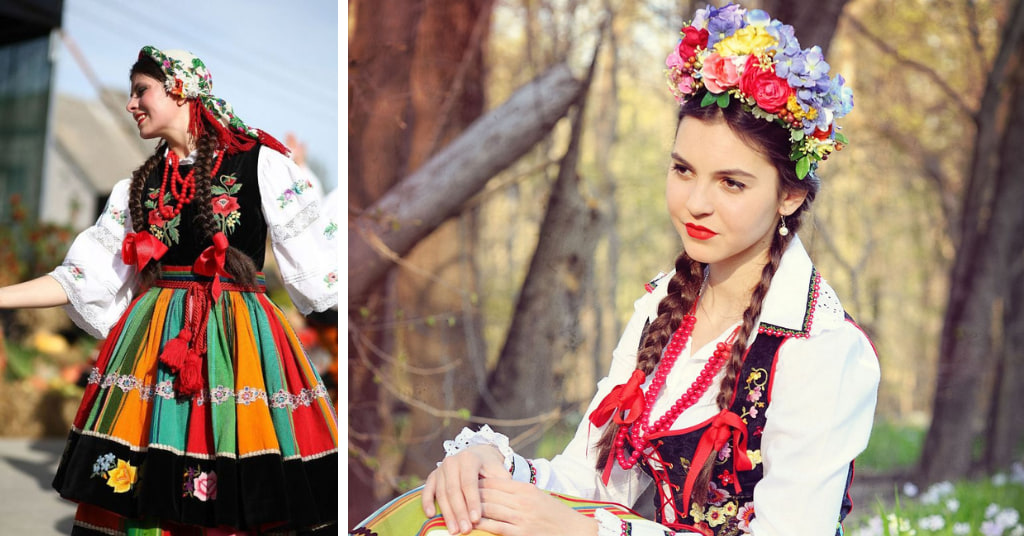
Let’s not forget about the gadgets: the beekeeper and farmer’s Kurpie costumes included exquisitely carved wood canes, birch or amber pipes, gorgeous horn snuff boxes and badger hide sacks.
If you saw gowns with a checkered pattern or stripes on the sides, laced white shirts, bulky woollen shawls draped on the shoulders, and a padded overcoat (the so-called angierka), you knew you’d seen a Kurpie lady during a festival.
Read this also:- Best 20 Men’s Outfits for Party
Strojeludowe.net reports that ‘the outfit was even more elegant owing to necklaces made of actual currency medals or crosses’.
6. The golden caps of Warmia
The Warmia regional women’s attire was simple yet elegant, and it was especially effective at emphasising female characteristics. The three-metre-long, wide, frilled garment was composed of velvet or silk and was paired with an exquisitely embroidered headdress in actual gold and silver.
These hats, knotted at the chin, were true laced masterpieces, to say the least. They were often made by nuns and could only be worn by married ladies. According to the Dom Warmiński website, headpieces varied in shape, needlework, and design.
The complexity varied according on the owner’s age, income, and the occasion for which the headpiece was worn.Those who enjoy fashion would enhance their look with a pair of earrings or hairpins (known as harnatle).
By the end of the nineteenth century, the Warmia area outfit was no longer popular. Women’s clothing has been in use for a longer time than men’s clothing.
7. Cieszyn: red stockings, pins & a belt
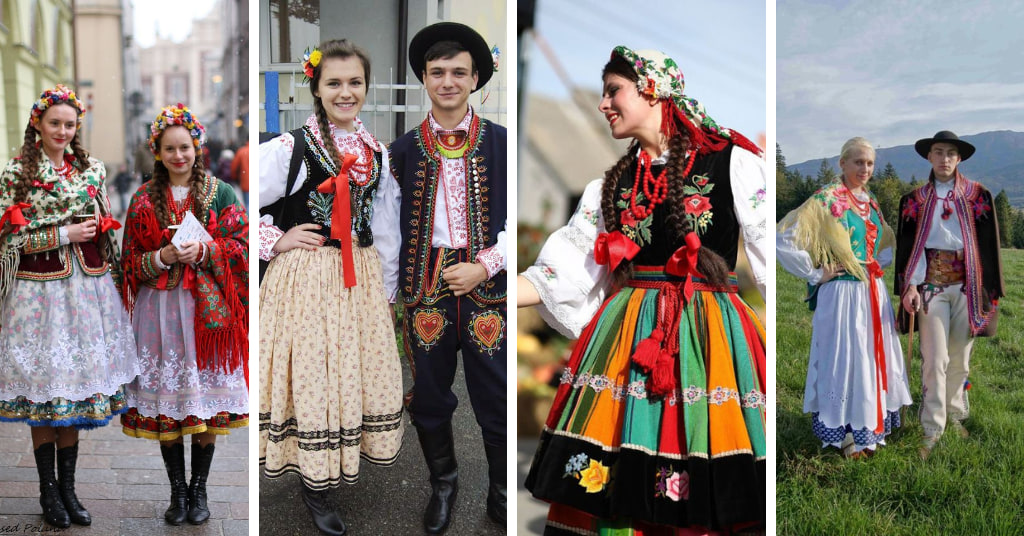
Cieszyn, a cosmopolitan city at the intersection of numerous significant trade routes, has Renaissance-inspired attire. The elegant female traditional dress of Poland was mostly of high-quality and expensive materials, adorned with gilded embroidery and beautiful jewels & Polo Shirt Outfit Ideas.
Round or heart-shaped pins were used to fix the collar of the customary white shirt (a kabotek), and silver Cieszyn belts with delicate chains (trzepotki) connected to them added to the outfit’s ‘glam’ factor.
All of the jewellery were cast and created by goldsmiths in the Cieszyn area.
8.The ‘oberek’ of Biłgoraj
Here’s a representation of a relatively modest traditional dress of Poland: basic, self-made, as well as typically made of linen or wool. During World War III, the style nearly disappeared from Biłgoraj’s environment.
Read this also:- The 10 best party outfits for women to try in 2024
‘The women’s outfit was antique and distinctive, it reminded the literary and artistic image of the Slavic costume,’ Strojeludowe.net reports. It had a blouse, skirt,as well as linen apron.
The most complex features, as usual, were the headpieces, which were bonnets having ribbons flowing down to the waistline and placed on wooden rims for married women. At the turn of the twentieth century, a so-called oberek was worn underneath the headscarf.
Finally, they wore pink beaded necklaces around their necks.
The most distinguishing feature of the men’s costume was a horseshoe-shaped bag known as a kalita, which was worn on the right shoulder almost exclusively on festivals.
Historical Data: Impact on Polish Fashion
Historical individuals have had an everlasting impact on the formation of traditional dress in Poland.
Their influence has changed the fashions, patterns,as well as cultural resonance of these clothes, elevating them above mere apparel and into a story of Poland’s past.
King Casimir the Great, who ruled in the fourteenth century, is an excellent example. His age was one of creative development and economic expansion, which naturally extended to the world of fashion.
Casimir’s taste for luxury, as well as elegance, is reflected in the typical garments of the time, which contain elaborate stitchwork and beautiful materials. Casimir’s influence on Polish sartorial history is evident in the costume of this time period, which combines grandeur and creative expression.
Queen Jadwiga of Poland was also important since her rule instilled a particular sense of regality as well as refinement in the traditional dress of Poland.
Hedwig, known for her exquisite taste, had a significant effect on the extravagant headdresses and decorative embellishments of traditional dress of Poland. These stylistic aspects, which reflect her grace, continue to influence modern designers and craftspeople today.
Each classic traditional dress of Poland, embellished by historical influences, tells a unique tale as well as represents the cultural uniqueness of its region.
- Casimir the Great’s reign emphasised elaborate needlework and sumptuous textiles, which can be seen in clothing today.
- Jadwiga of Poland’s reign is reflected in the rich headdresses and decorative decorations that distinguish the traditional dress of Poland & party outfits for men.
Examining the clothing associated with these great personalities provides insight into their rich history as well as cultural heritage. These traditional dress of Poland are more than simply a visual feast; they are a tribute to the creativity and skill passed down through the years.
Embracing the traditional dress of Poland honours the heritage of these significant personalities, preserving their tales as well as accomplishments through the timeless beauty of clothes.
Conclusion:-
Polish folklore and traditional materials, like the famous Polish vodka, play an important part in the traditional dress of Poland, which is a vibrant representation of Poland’s different regions and rich rural culture.
Each costume, with its distinctive needlework as well as brilliant colours, tells the story of a certain location.
Our exploration of the traditional dress of Poland has brought us through Poland’s many geographies, from Silesia’s cultural mix to Wielkopolska’s distinct forms. We explored lesser-known but captivating apparel in places like Lubusz, Kuyavia, and Dobrzyń, showing the inventiveness of local craftspeople.
Historical characters such as Casimir the Great as well as Jadwiga, among many other renowned Polish people, have had a great impact on the traditional dress of Poland, leaving their mark in the fabric of Polish culture.
Traditional Polish apparel is more than simply clothes; it honours the country’s past, and artistry,as well as the diverse regional cultures that create Poland’s distinct identity.
Recommended Readings:



